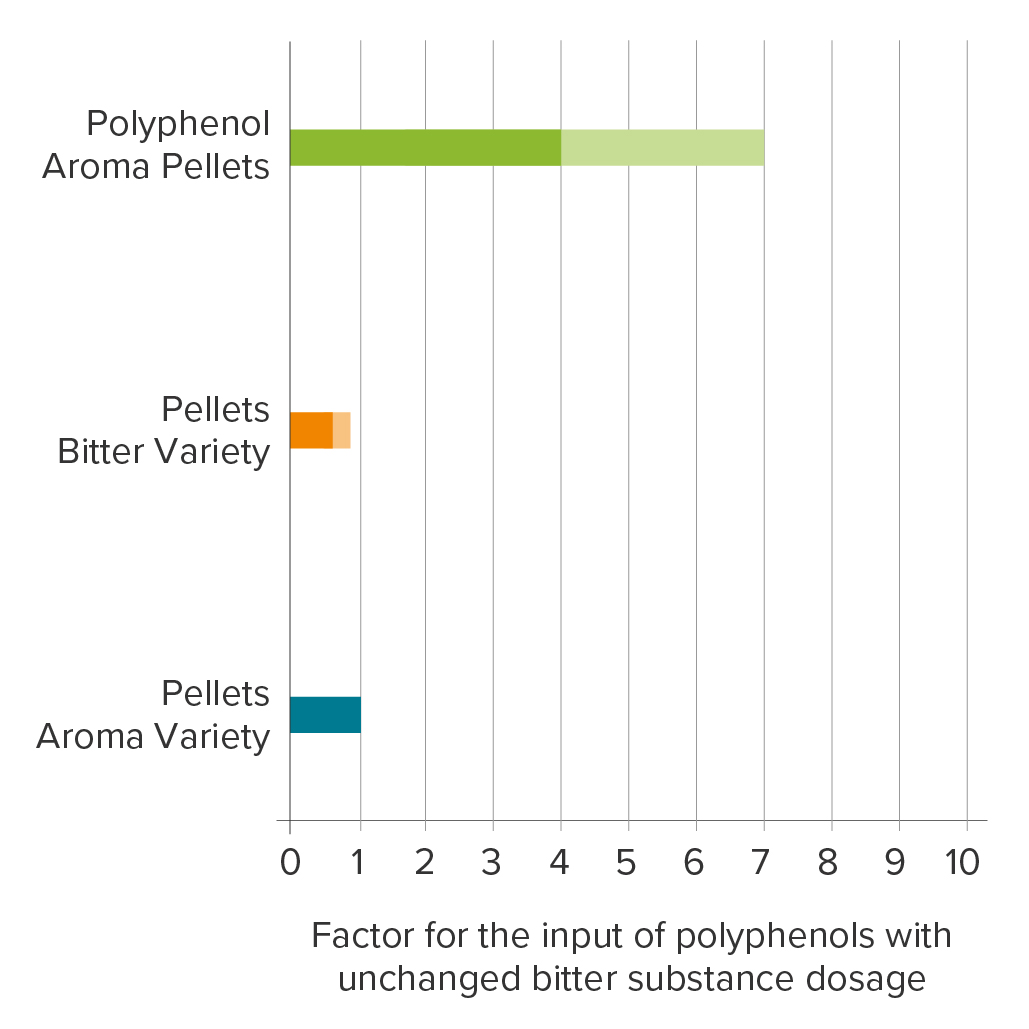
Polyphenol Aroma Pellets
Overview
Polyphenol Aroma Pellets are a hop product made from leaf hops, added to the wort kettle during the boiling process. They are rich in a range of hop polyphenols.
Polyphenol Aroma Pellets can be added to provide additional polyphenols in situations where high levels of pure starch or sugar adjuncts are used. The addition of polyphenols helps to ensure that sufficient protein coagulation and precipitation occurs during the brewing process.
Polyphenol Aroma Pellets provide some hop aroma and minimal amounts of bitterness.

Specifications
- Short description
- de-bittered hop powder (from production of type 45 pellets) compressed into cylindrical pellets
- Alpha acids
- < 1.5 %
- Hop oils
- < 0.1 %
- Moisture content
- < 11 %
- Polyphenols
- > 4 %
Properties
Appearance
Polyphenol Aroma Pellets are pale yellow-green pellets, approximately 8 mm x 10 - 25 mm in size (diameter x length).
Flavor
Polyphenol Aroma Pellets produce a minimal bitter flavor. The hard resins and polyphenols in the pellets have been shown to contribute to improved mouthfeel and overall beer flavor. Moreover, aroma compounds (e.g. linalool) can contribute to the hoppy character of beer.
Utilization
Actual utilization will vary from brewery to brewery due to differences in equipment and process conditions.
Quality
All Hopsteiner® products are processed in facilities which fulfill internationally recognized quality standards.
Packaging
Our products are delivered in their respective recommended standard packaging. Alternatives may be possible upon customer request.
Standard packages of our processing plants in the USA (US) and Germany (DE) are:
- softpack under inert gas in 5-layer aluminum composite foils (US / DE)
Suitable pack sizes are available on request.
Usage
Polyphenol Aroma Pellets are used to supplement the polyphenols derived from malt and hops to ensure sufficient precipitation of proteins, thereby improving the colloidal stability of the finished beer.
Dosage
The quantity of Polyphenol Aroma Pellets to be added depends on the application and will vary according to the raw materials and other hop products used in the brewing process. They can be added at any time during the boil.
To establish what impact they will have on beer flavor, brewing trials are recommended as the quality and quantity of the compounds imparting the bitterness, aroma and flavor will vary among varieties.
Application
Polyphenol Aroma Pellets can be manually weighed out and added directly to the wort. Alternatively, owing to their free-flowing nature, additions of Polyphenol Aroma Pellets can be automated.
Storage
The recommended storage temperature in the original unopened packaging is < 5 °C (41 °F).
Short-term, transport-related temperature deviations do not affect product quality.
Best Before Date
Under the recommended storage conditions, the shelf life from the date of production/ packaging is at least 5 years.
Safety
Ensure good ventilation of the workplace and wear personal protective equipment. Avoid contact with eyes and skin. Do not inhale vapors or dusts. For full safety information, please refer to the relevant Hopsteiner® safety data sheet.
Analytical Methods
International approved methods listed in commitees such as ASBC or Analytica-EBC using current standards are applied.
Product analytics
- Analytica-EBC 7.14 (Spectro)
Low molecular weight polyphenols can be measured by HPLC using the relevant pure substances as external calibration standards.
- Analytica-EBC 7.4 (LCV)
- Analytica-EBC 7.5 (LCV)
- ASBC Hops-6B (LCV)
- Analytica-EBC 7.7 (HPLC)
- ASBC Hops-14 (HPLC)
- ASBC Hops-6A (Spectro)
Due to the low amount of hop oil, the concentration cannot be measured using any of the methods currently available.
Technical Support
We are pleased to offer assistance and advice on:
- safety data sheets
- support for brewing trials on a pilot or commercial scale
- analytical services and information about analytical procedures
Disclaimer: The information provided in this document is believed to be correct and valid. However, Hopsteiner® does not guarantee that the information provided here is complete or accurate and thus assumes no liability for any consequences resulting from its application.
Last updated: 23/11/2023
Save PDF